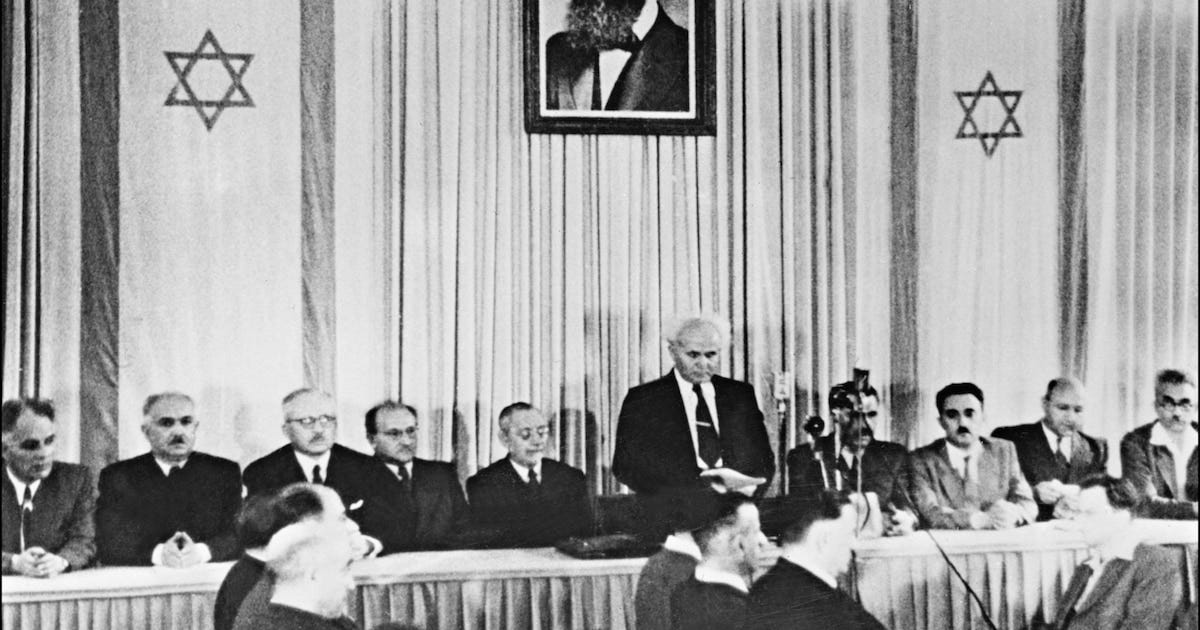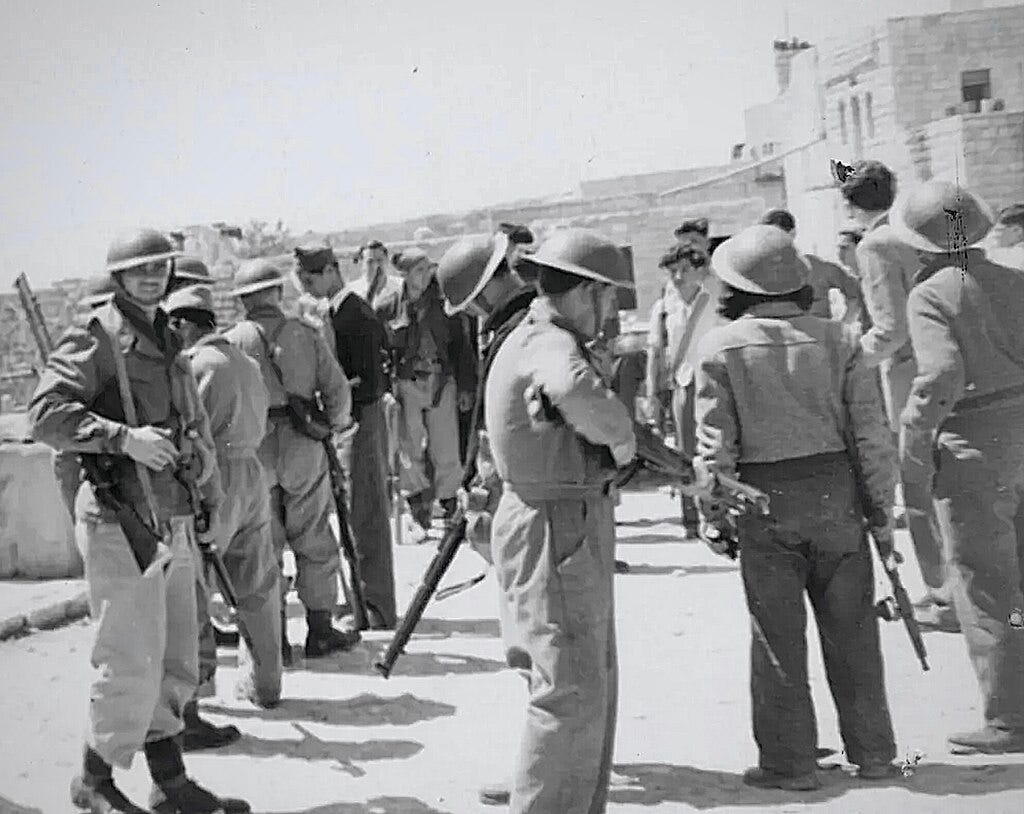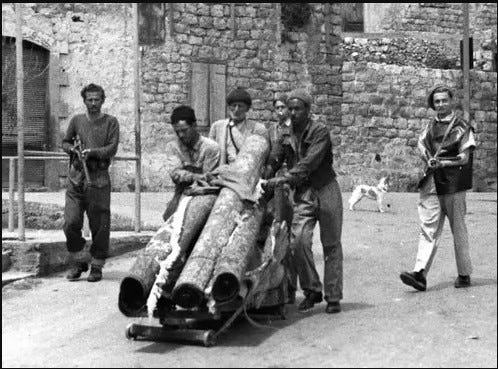The events of Deir Yassin in April 1948 are etched in the collective memory of Palestinians as a symbol of pain and injustice. Yet, attempts to rewrite history persist, with apologists for Israeli actions offering convoluted justifications to sanitise what was, in reality, a massacre of civilians. Bailey Pasternak’s opinion piece Deir Yassin: The “Massacre” That Never Was in the Algemeiner which I just read, epitomises this trend. I encountered the article during a Facebook debate, where it was presented as evidence that the massacre never occurred—or, if it did, that it was merely a tragic "military failure" rather than the calculated brutality it truly was.
The Reality of Deir Yassin
Deir Yassin was a quiet village west of Jerusalem. The Haganah, the leading Jewish militia at the time, had signed a non-aggression pact with its residents, making it an unlikely “hostile stronghold.” Yet, on April 9, 1948, Irgun and Lehi paramilitaries, with Haganah approval, launched a brutal assault on the village. Over 100 Palestinians, including women, children, and the elderly, were killed. Survivors recounted horrific atrocities: bodies were mutilated, homes looted and destroyed, and families shattered. The massacre, part of "Operation Nachshon"—a military effort to break the blockade on the road to Jerusalem—was not an isolated event but a calculated act of terror.
The attack succeeded in sowing fear among Palestinians, prompting thousands to flee their homes. Survivors who escaped became unwilling messengers, spreading stories of unimaginable violence and destruction. These accounts spread rapidly through Palestinian communities, amplifying fear and accelerating the exodus. This was no accident; it was strategic. By allowing some to survive and recount the horrors, the attackers ensured the psychological impact extended far beyond the borders of Deir Yassin.
The massacre was part of a broader military strategy orchestrated by David Ben-Gurion, the leader of the Jewish Agency and later Israel’s first prime minister. By the end of March 1948, Abd al-Qadir al-Husayni’s troops had effectively blockaded Jerusalem, cutting off supply routes and forcing the Jewish population into rationing. In response, Ben-Gurion ordered the launch of Operation Nachshon to break the siege and secure the road to Jerusalem. While initially conceived as a limited operation, Nachshon marked the beginning of a more expansive and systematic military campaign: Plan Dalet.

Plan D
Plan Dalet (Plan D) was a comprehensive blueprint developed by the Haganah and finalized on March 10, 1948, under Ben-Gurion’s direction. Its stated objective was to secure the territory allocated to the proposed Jewish state by the UN Partition Plan and to defend its borders against anticipated Arab invasions. However, the plan went further, calling for the conquest of strategic areas beyond the proposed borders, including Palestinian villages and towns that lay along key transportation routes or near Jewish settlements. The plan’s guidelines included the destruction of villages, expulsion of inhabitants, and the establishment of Jewish control over these areas.
The tactics outlined in Plan Dalet were brutal and systematic. Villages were to be encircled, searched, and, in cases of resistance, destroyed. Inhabitants were to be expelled, and their homes and fields burned or mined to prevent return. The plan also called for the confiscation of weapons, the detention of “politically suspect” individuals, and the establishment of Jewish-administered governance in occupied areas. These measures were not merely defensive; they were designed to ensure Jewish territorial control and demographic dominance in preparation for the declaration of the State of Israel.
Deir Yassin became one of the first and most infamous implementations of Plan Dalet. The massacre was not an aberration but a deliberate tactic to instill fear and drive Palestinians from their homes. By April 1948, the Haganah, Palmach, Irgun, and Lehi were carrying out coordinated attacks on Palestinian villages and urban centers, including Tiberias, Haifa, Jaffa, and Safed. Over 500 villages were depopulated, and more than 700,000 Palestinians were displaced during the 1948 Nakba. The violence at Deir Yassin, with its graphic accounts of mutilation, rape, and looting, served as a psychological weapon, accelerating the mass exodus of Palestinians from their homeland.
The film Born in Deir Yassin captures many of these harrowing stories, , featuring chilling admissions from soldiers who are proud and believe they were simply following orders—and some even feel they should have done more. Deir Yassin is not an anomaly; similar atrocities unfolded in countless other villages, including two that I also have reviewed films about: Tantura and Lubya.
Whitewashing the Unthinkable
Pasternak dismisses the massacre as a "military failure," claiming the attackers intended to minimise civilian casualties. This narrative strains credulity. Even if the loudspeaker truck with its evacuation warnings had reached the village, would the subsequent indiscriminate use of grenades and automatic fire into homes align with a genuine concern for civilian lives? The veterans from the Deir Yassin attack know exactly whay they did, what that led to and who ordered them. The defenders of Deir Yassin were ill-equipped and vastly outnumbered. Most residents were non-combatants who were offered no safe passage—only death or displacement.
Attempts to portray the atrocities as “isolated incidents” overlook the broader context. The Zionist militias’ actions in Deir Yassin were not anomalies; they were part of a calculated strategy to clear Palestinian villages along strategic routes. Documents from Zionist leaders at the time reveal their awareness of and, in some cases, approval of the terror tactics used to secure territory.
The Legacy of Deir Yassin
The effects of Deir Yassin are not confined to history books. The massacre has become a rallying cry for Palestinian resistance and a painful reminder of the ongoing dispossession of their homeland. For Palestinians, Deir Yassin is emblematic of the injustices they continue to face: military occupation, forced evictions, and systematic erasure of their history.
Yet, the memory of Deir Yassin is not just under assault in the physical world but also in the realm of narratives. The efforts to downplay or deny what happened reflect a broader campaign to delegitimise Palestinian suffering. By recasting atrocities as “necessary evils” or dismissing them altogether, the propagators of this revisionism seek to absolve Israel of accountability.
Reckoning with the Truth
Acknowledging the massacre of Deir Yassin is not merely about assigning blame; it is about confronting the reality of Israel’s founding and the cost borne by Palestinians. The path to justice begins with truth-telling. Attempts to rewrite history—to diminish the scale of the violence or to justify it as a “military objective”—do not bring peace. They perpetuate harm by denying Palestinians their right to justice, recognition, and return.
Deir Yassin was a massacre. No euphemisms, justifications, or historical distortions can change that fact. For those committed to justice, it is a duty to ensure that the memories of the victims are not erased and that their stories fuel the fight for Palestinian liberation.
In their own words
While apologists attempt to downplay or justify the ongoing displacement and oppression of Palestinians, Israeli leaders have been remarkably clear about their intentions throughout history. The following quotes, spanning decades, illustrate a consistent pattern of policies aimed at the removal and replacement of the indigenous Palestinian population.
David Ben-Gurion, Israel's first Prime Minister (1948-1953, 1955-1963):
"We must expel Arabs and take their places...and, if we have to use force... then we have force at our disposal." (from Nur Masalha, Expulsion of the Palestinians, p. 66)
"The compulsory transfer of the [Palestinians] from the valleys of the proposed Jewish state could give us something which we never had, even when we stood on our own during the days of the first and second Temples. We are given an opportunity which we never dared to dream of in our wildest imaginings." (from Benny Morris, Righteous Victims, p. 142)
"In many parts of the country new settlement will not be possible without transferring the [Palestinian peasants]... Jewish power, which grows steadily, will also increase our possibilities to carry out the transfer on a large scale." (from Righteous Victims, p. 143)
"With compulsory transfer we [would] have a vast area [for settlement]. I support compulsory transfer. I don't see anything immoral in it." (from Righteous Victims, p. 144)
"After the formation of a large army in the wake of the establishment of the [Jewish] state, we shall abolish partition and expand to the whole of the Palestine" (from The Birth of Israel: Myths and Realities, p. 22)
Chaim Weizmann, Israel's first President (1949-1952):
"[the indigenous Palestinian population was akin to] the rocks of Judea, as obstacles that had to be cleared on a difficult path." (from Expulsion of the Palestinians, p. 17)
Moshe Sharett, Israel's second Prime Minister (1953-1955):
"We have forgotten that we have not come to an empty land to inherit it, but we have come to conquer a country from people inhabiting it" (from Righteous Victims, p. 91)
On the partition of Palestine into two states: "The [Palestinian] Arab reaction would be negative because they would lose everything and gain almost nothing ...They would lose the richest part of Palestine; they would lose major Arab assets, the orange plantations, the commercial and industrial centers and the most important sources of revenue for their government which would become impoverished; they would lose most of the coastal area, which would also be a loss to the hinterland Arab states...It would mean that they would be driven back to the desert." (from Expulsion of the Palestinians, p.59)
"With regard to the refugees, we are determined to be adamant while the war lasts. Once the return tide starts, it will be impossible to stem it, and it will prove our undoing. As for the future, we are equally determined to explore all possibilities of getting rid, once and for all, of the huge [Palestinian] Arab minority [Palestinian Israeli citizens of Israel] which originally threatened us. What can be achieved in this period of storm and stress [the 1948 war] will be quite unattainable once conditions get stabilized.” (from The Birth of Israel: Myths and Realities, p. 105)
Yosef Weitz, director, Jewish National Fund Land Settlement Committee (1932-1948):
"...the transfer of [Palestinian] Arab population from the area of the Jewish state does not serve only one aim--to diminish the Arab population. It also serves a second, no less important, aim which is to advocate land presently held and cultivated by the [Palestinian] Arabs and thus to release it for Jewish inhabitants." (from Expulsion Of The Palestinians, p. 94-95)
"It must be clear that there is no room in the country for both peoples...If the Arabs leave it, the country will become wide and spacious for us...The only solution is a Land of Israel...without Arabs...There is no way but to transfer the Arabs from here to the neighboring countries, to transfer all of them, save perhaps for [the Palestinian Arabs of] Bethlehem, Nazareth, and the old Jerusalem. Not one village must be left, not one tribe." (from Benny Morris, The Birth of the Palestinian Refugee Problem, p. 27)
"Once again I come face to face with the land settlement difficulties that emanate from the existence of two people in close proximity...only population transfer and evacuating this country so it would become exclusively for us is the solution. " (from Expulsion Of The Palestinians, p. 132)
Arthur Ruppin, head of the Jewish Agency from 1933 to 1935 and one of the founders of Tel Aviv:
"I do not believe in the transfer of individuals. I believe in the transfer of entire villages." (from The Birth of the Palestinian Refugee Problem Revisited, p. 50.
Moshe Dayan, chief of staff of the Israeli military and Minister of Defense during the 1967 war:
"Jewish villages were built in the place of Arab villages. You do not even know the names of these Arab villages, and I do not blame you because geography books no longer exist, not only do the books not exist, the Arab villages are not there either...There is not one single place built in this country that did not have a former Arab Population." (from Ha'aretz, April 4, 1969)
"We shoot at those from among the 200,000 hungry Arabs who cross the line [to graze their flocks]...Arabs cross to collect the grain that they left in the abandoned villages and we set mines for them and they go back without an arm or a leg. [It may be that this] cannot pass review, but I know no other method of guarding the borders." (from Righteous Victims, p. 275)
"What cause have we to complain about [the Palestinians'] fierce hatred to us. For eight years now, they sit in their refugee camps in Gaza, and before their eyes we turn into our homestead the land and villages in which they and their forefathers have lived... .Let us make our reckoning today. We are a generation of settlers, and without the steel helmet and gun barrel, we shall not be able to plant a tree or build a house." (from Avi Shlaim, The Iron Wall, p. 101)
Yigal Allon, commander, Palmach (elite force of Zionist militia Haganah) (1945-1948), Lieutenant General, Israeli army (1948-1949):
"The confidence of thousands of Arabs of the Hula [Valley] was shaken...We had only five days left...until 15 May [1948]. We regarded it as imperative to cleanse the interior of the Galilee and create Jewish territorial continuity in the whole of the Upper Galilee...I gathered the Jewish mukhtars [Kibbutz chiefs], who had ties with the different Arab villages, and I asked them to whisper in the ears of several Arabs that a giant Jewish reinforcement had reached the Galilee and were about to clean out the villages of Hula, [and] to advise them as friends, to flee while they could. And rumour spread throughout Hula that the time had come to flee. The flight encompassed tens of thousands. The stratagem fully achieved its objective." (from The Birth of the Palestinian Refugee Problem, p. 122)
Yitzhak Rabin, Prime Minister of Israel (1974-1977, 1992-1995)
"We walked outside, Ben-Gurion accompanying us. Allon repeated his question, What is to be done with the Palestinian population. ' Ben-Gurion waved his hand in a gesture which said 'Drive them out!" (from New York Times, October 23, 1979)
Ariel Sharon, Prime Minister of Israel (2001-2006)
"It is the duty of Israeli leaders to explain to public opinion, clearly and courageously, a certain number of facts that are forgotten with time. The first of these is that there is no Zionism, colonialization, or Jewish State without the eviction of the Arabs and the expropriation of their lands." (from Agence France Presse, November 15, 1998)
These are not isolated remarks; they represent a long-standing and deliberate policy of ethnic cleansing and dispossession. History does not forget—these words, spoken by Israel’s own leaders, are a testament to the reality that so many still try to deny.
All articles on Diaspora Dialogue are free to read for one year from publication. If you’ve enjoyed this piece and would like to support my work, you can do so by subscribing, or by buying me a coffee. Thank you for reading and being part of the dialogue!







